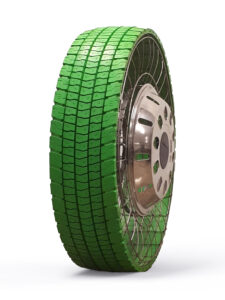16 Feb With Marangoni Ringtread tyres 74% less CO2 emissions, 77% less resource consumption

Example life cycle assessment for retreaded tyres.
With the support of the Department of Industrial Engineering at the University of Trento, Marangoni has determined an exemplary life cycle assessment for a retreaded 385/65R22.5 truck tyre that was retreaded with RINGTREAD BLACKLINE WSS 300 M. The results were compared with a new tyre for the same application.
It is not surprising that the production of a retreaded tyre basically consumes less energy and resources. But the fact that the differences are so great may surprise some tyre experts.
According to the results of the life cycle assessment, retreaded tyres are more environmentally friendly than new tyres in all eleven categories examined. The following values were determined for the main categories in comparison to new tyres:
CO2 emissions (GWP/ Global Warming Index, calculated in kg) were -74% lower for the retreaded tyre. In absolute figures, that is 310 kg of CO2 emissions that are not emitted compared to a (single) new tyre.
- RU-E (fossil resource impact index): -77%
- RU-MM (resource impact index for raw material extraction): -75%.
- PM10 (particulate matter emissions): -55%
- WS (water consumption): -83%.
- AP (acidification of precipitation): -70%
- ODP (depletion of the ozone layer): -74%
If you want to help the environment, start using retreaded tyres!
The life cycle assessment was carried out in accordance with the requirements of the ISO 14040 and ISO 14044 standards; the PCR (Product Category Rule) applied is that for tyres (UL10006) in accordance with ISO 14025. The SimaPro Version 9.4 Multi User software was used for the calculation.
The following assumptions were made in the calculation:
The rolling resistance and mileage of the retreaded tyre correspond exactly to those of the new tyre. Measurements have shown that these values are identical, if not better, for retreaded tyres. This study was based on the «cautious» assumption of equivalence.
The carcass is not taken into account in the life cycle assessment of the retreaded tyre, as it is a waste product that would have a significant impact on disposal. Marangoni believes that these comparative figures should be taken into serious consideration when deciding between a new and a retreaded tyre.





